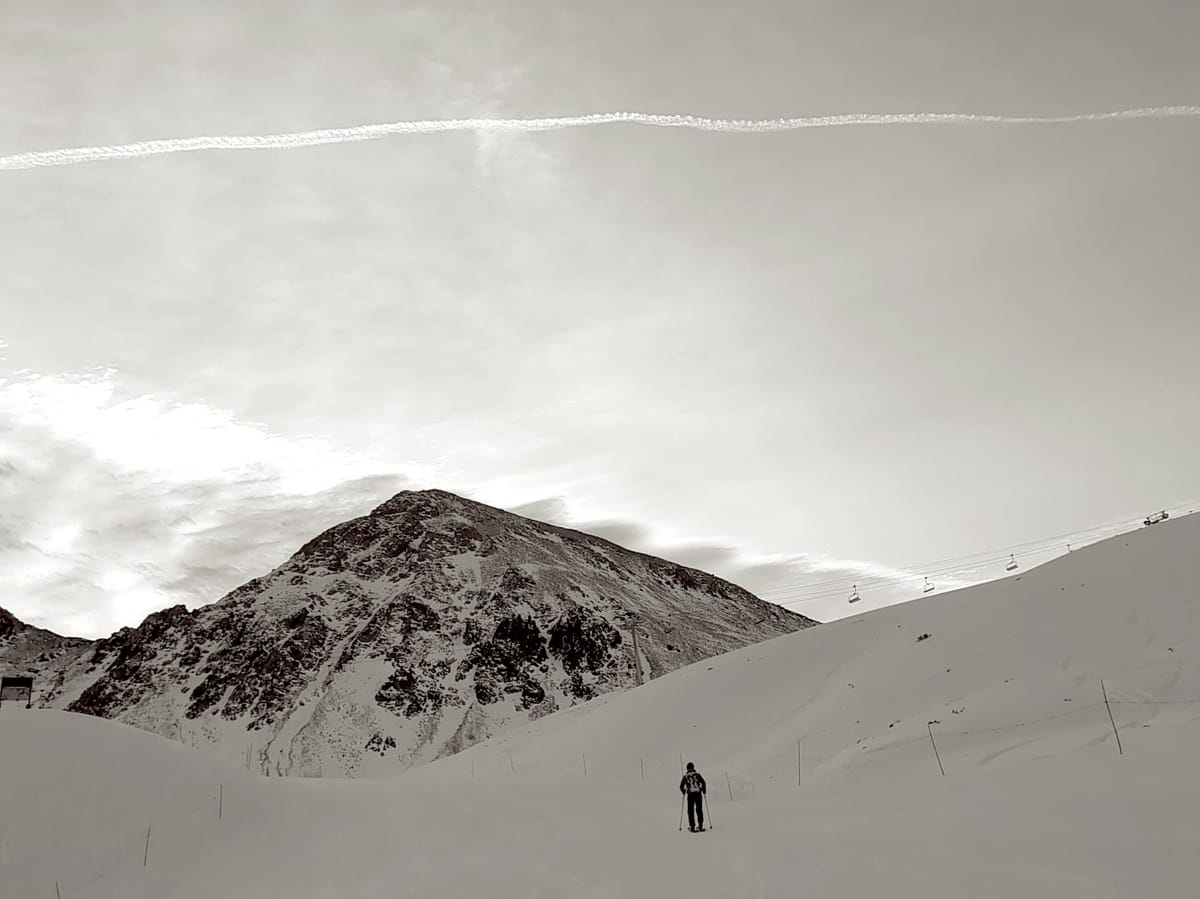Our Journey So Far

As we outlined in our first notebook post, contrail management presents a potentially huge climate opportunity. The scientific journey leading us here has been fascinating – but it’s far from over. This post offers a brief retrospective for some of our proudest accomplishments on the journey so far, and a few thoughts for where we'll go next.
Origins and Evolution
Our interest in contrail avoidance started with the paper "Beyond Contrail Avoidance: Efficacy of Flight Altitude Changes to Minimise Contrail Climate Forcing" by Roger Teoh, Ulrich Schumann, and Marc Stettler. This study suggested small-scale altitude adjustments could effectively reduce the bulk of harmful contrail formation. Contrail impacts were known to be large prior to this study, but this paper emphasized that mitigation should be possible with extremely low operational impacts. At the time it was written, Roger was a Ph.D. student of Marc's at Imperial College. Roger has since graduated, and Roger and Marc have become core members of our team. Ulrich Schumann, former head of the Institute of Atmospheric Physics at the German Aerospace Center (DLR), remains a close collaborator.
Notably, this paper gained the attention of Ian McKay (founder of Orca Sciences, a small climate and energy think-tank sponsored by Gates Ventures) and Ken Caldeira (Senior Scientist at Gates Ventures). They published a commentary in Nature highlighting contrail management as a notably cheap climate intervention that might be realistically achievable. The seeds of Contrails.org collected at Orca Sciences with Ian’s leadership, eventually coalescing as a standalone project at Breakthrough Energy. From Breakthrough Energy, we continue to expand our research and impact, growing an ever-larger consortium of academic, industry, and government partners to establish proven contrail management approaches at scale.
Research and Publications
From the beginning, it was clear we needed to be able to forecast contrail effects across an airspace in real time. Our starting point was the original Contrail Cirrus Prediction (CoCiP) model, developed by Professor Ulrich Schumann at the German Aerospace Center (DLR). CoCiP is a parameterized Lagrangian model (i.e. an atmospheric model that follows air parcels as they move through the atmosphere) that can efficiently simulate contrails and downstream climate effects from individual flight paths. While this makes it useful for estimating contrail impacts for flights that already occurred, it is not as well suited for flight planning or air traffic management applications. We set out to generalize CoCiP to approximate contrail formation and climate impacts anywhere on a 4D spatiotemporal grid (what we call CoCiP Grid). This innovation made it possible to integrate contrail-aware route optimization directly into flight planning and air traffic management systems, just like any other weather data layer (e.g. turbulence, icing).
Using CoCiP Grid, we worked with FlightKeys, a global flight planning service provider, to integrate contrail forecasts into a commercial flight planning system. Flightkeys performed a fleet-wide contrail avoidance simulation on 84,840 flights to assess the feasibility and operational impacts of contrail avoidance. This research, published in early 2024, demonstrates that contrail formation can be reduced by up to 59% with a minimal fleet-wide fuel penalty of as low as 0.5%. This result showed that (in theory) contrail avoidance could be implemented on individual flights without substantial increases in operational costs or fuel consumption.
Another milestone for our group was publishing the Global Aviation emissions Inventory based on ADS-B (GAIA) dataset. GAIA utilizes historical flight trajectories from Automatic Dependent Surveillance–Broadcast (ADS-B) data and reanalysis weather data to develop a detailed aviation emissions inventory for all flights between 2019 and 2021. The creation of this dataset required careful curation of aircraft trajectories across multiple years (~104 million flights). Each flight was run through a cascade of models, including CoCiP, to estimate aircraft emissions and downstream contrail impacts. This high-resolution dataset has been crucial for assessing aviation's environmental impact and informing potential mitigation strategies. In 2019, the inventory recorded 40.2 million flights covering 61 billion kilometers, consuming 283 million metric tonnes of fuel, and emitting 893 million tonnes of CO₂, 4.49 million tonnes of NOₓ, 21,400 tonnes of non-volatile particulate matter (nvPM) mass.
Open tools
Since our early days at Orca, we've wanted to develop our research as open tools that enabled other groups to access and build on the work. We focused this energy into building pycontrails, and opinionated Python framework that scaffolds atmospheric models and performant geospatial data processing. This framework implements all the models we've used for publishing, including the original trajectory-oriented CoCiP and our generalized CoCiP Grid , amongst many others. We developed pycontrails to appeal to graduate students and industry engineers alike, hoping that common tooling and analyses could align the community and yield insights faster. To expand access further, we deployed a hosted version of pycontrails (Contrails API) that includes meteorology from the European Center for Medium Range Weather Forecasting (ECMWF) built-in.
We've also played a key role in shepherding the development of the Poll-Schumann model (PS model) aircraft performance model into. By working closely with Ian Poll and Ulrich Schumann, the project has made substantial progress and creating a commercial-grade aircraft performance model openly available to the research community. We continue to expand the PS model to encompass more aircraft types and further refine the accuracy of the model.
Collaborations and Industry Impact
While research and open tools are critical, we're also focused on testing our work in the real world. In 2023, we collaborated with American Airlines and Google Research to run a ground-breaking study on the real-world feasibility of per-flight contrail avoidance in commercial aviation. Over six months, American Airlines pilots conducted 70 flights using AI-based predictions to adjust routes likely to produce contrails. The results were promising, achieving a 54% reduction in contrail formation with minimal additional fuel consumption.
This collaboration not only demonstrated the feasibility of contrail avoidance but also highlight the potential for scalable solutions within the industry. These partnerships are crucial for translating scientific research into real-world applications and improving our understanding of whats possible. We're excited to continue collaborating with operational partners to expand real-world testing and retire risks on the path to implementing contrail avoidance.
Global Recognition and Media Coverage
While we remained focused on scientific and technological progress, our work has garnered attention from leading media outlets and scientific communities. Publications such as The New York Times, MIT Technology Review, and Nature have featured their research, bringing broader awareness to the issue of contrail-induced warming and the efforts to combat it.
Looking Ahead
This is just the beginning for Contrails.org. We're on a mission to enable the development and deployment of large-scale contrail management to significantly and immediately reduce aviation's climate warming impact. We envision a world where intelligent route planning and management eliminates climate warming contrails (1 - 2% of human-caused warming) with near-zero cost.
But there is much work to do. To make contrail management a practical reality, we need to proactively advance science in specific areas, build effective tools, and better understand contrail optimal routing. We're pursuing a research agenda that cuts across these needs, expanding collaborations with researchers, airlines, and decision makers. We aim to simultaneously improve improve contrail modeling and observation, while building the tools and protocols to avoid contrails in practice.
We've made remarkable progress in understanding the climate effects of contrails – now comes the hard part. Stay tuned for future posts outlining progress along the way.

